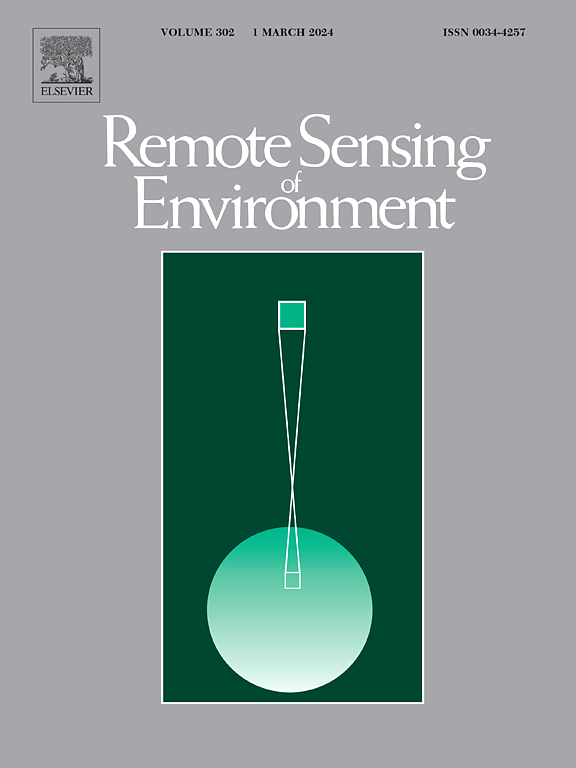Large-scale diurnal responses of solar-induced chlorophyll fluorescence (SIF) to varying heat and water stresses: Implications for monitoring SIF variations from satellite observations
IF 11.1
1区 地球科学
Q1 ENVIRONMENTAL SCIENCES
引用次数: 0
Abstract
Satellite observations of solar-induced chlorophyll fluorescence (SIF) offer a promising approach for monitoring plant heat and water stresses across spatial scales. Most studies have focused on seasonal responses of satellite-observed SIF and its physiological component, fluorescence efficiency (), to heat and water stresses. However, their diurnal responses remain poorly understood. Besides, polar-orbiting satellites typically use a daily correction factor to upscale fixed-time SIF observations into daily averages (). Given the diurnal SIF variations, the reliability of this approach under stress conditions is uncertain. In this study, we used the ratio of SIF to near-infrared radiance of vegetation (NIRvR) as a a linear approximation of . Then, we applied the eXtreme Gradient Boosting (XGBoost) algorithm to model hourly observations of summer (June–August) SIF and from Orbiting Carbon Observatory-3 (OCO-3) data. Our modeling was constrained to mainland China from 2019 to 2022. We calculated anomalies in SIF and at different times of the day and conducted linear regressions on them with daily air temperature or soil moisture anomalies. Our results showed that the responses of SIF and to stresses varied significantly with time of day and vegetation type. On days experiencing high water and heat stresses, morning and afternoon SIF exhibited weaker declines than midday. In contrast, morning generally exhibited stronger increases than midday, whereas afternoon showed weaker increases. Such diurnal differences in SIF and responses were more pronounced in forests than in grasslands and intensified with rising water and heat stress levels. Additionally, we found that morning polar-orbiting satellite SIF observations tended to overestimate changes, whereas midday observations tended to underestimate them. These biases also intensified with rising stress levels. Our findings emphasize the importance of diurnal satellite SIF observations in deepening our understanding of plant responses to water and heat stress, as well as in improving the monitoring of plant stresses.
太阳诱导的叶绿素荧光(SIF)对不同热量和水分胁迫的大尺度日响应:从卫星观测监测SIF变化的意义
对太阳诱导叶绿素荧光(SIF)的卫星观测为跨空间尺度监测植物热量和水分胁迫提供了一种很有前景的方法。大多数研究侧重于卫星观测到的 SIF 及其生理成分荧光效率(Φf)对热胁迫和水胁迫的季节性响应。然而,人们对它们的昼夜响应仍然知之甚少。此外,极轨卫星通常使用日校正因子将固定时间的 SIF 观测数据放大为日平均值(SIFdaily)。考虑到 SIF 的昼夜变化,这种方法在应力条件下的可靠性并不确定。在本研究中,我们使用 SIF 与植被近红外辐射率(NIRvR)之比作为 Φf 的线性近似值。然后,我们采用极端梯度提升(XGBoost)算法,对轨道碳观测站-3(OCO-3)数据中的夏季(6-8月)SIF和Φf的每小时观测数据进行建模。我们的建模以 2019 年至 2022 年的中国大陆为约束条件。我们计算了一天中不同时段的SIF和Φf异常值,并将其与日气温或土壤水分异常值进行了线性回归。结果表明,SIF 和 Φf 对胁迫的响应随一天中不同时间和植被类型的变化而显著不同。在水和热胁迫较强的日子里,上午和下午的 SIF 下降幅度比中午要小。与此相反,上午的Φf通常比中午有较强的上升,而下午的Φf则上升较弱。在森林中,这种SIF和Φf反应的昼夜差异比在草地中更为明显,并随着水和热应力水平的上升而加剧。此外,我们还发现,早晨极轨卫星的SIF观测结果往往会高估SIF的日变化,而中午的观测结果则往往会低估SIF的日变化。这些偏差还随着压力水平的上升而加剧。我们的研究结果强调了昼夜卫星 SIF 观测在加深我们对植物对水分和热量胁迫反应的理解以及改善植物胁迫监测方面的重要性。
本文章由计算机程序翻译,如有差异,请以英文原文为准。
求助全文
约1分钟内获得全文
求助全文
来源期刊

Remote Sensing of Environment
环境科学-成像科学与照相技术
CiteScore
25.10
自引率
8.90%
发文量
455
审稿时长
53 days
期刊介绍:
Remote Sensing of Environment (RSE) serves the Earth observation community by disseminating results on the theory, science, applications, and technology that contribute to advancing the field of remote sensing. With a thoroughly interdisciplinary approach, RSE encompasses terrestrial, oceanic, and atmospheric sensing.
The journal emphasizes biophysical and quantitative approaches to remote sensing at local to global scales, covering a diverse range of applications and techniques.
RSE serves as a vital platform for the exchange of knowledge and advancements in the dynamic field of remote sensing.
 求助内容:
求助内容: 应助结果提醒方式:
应助结果提醒方式:


